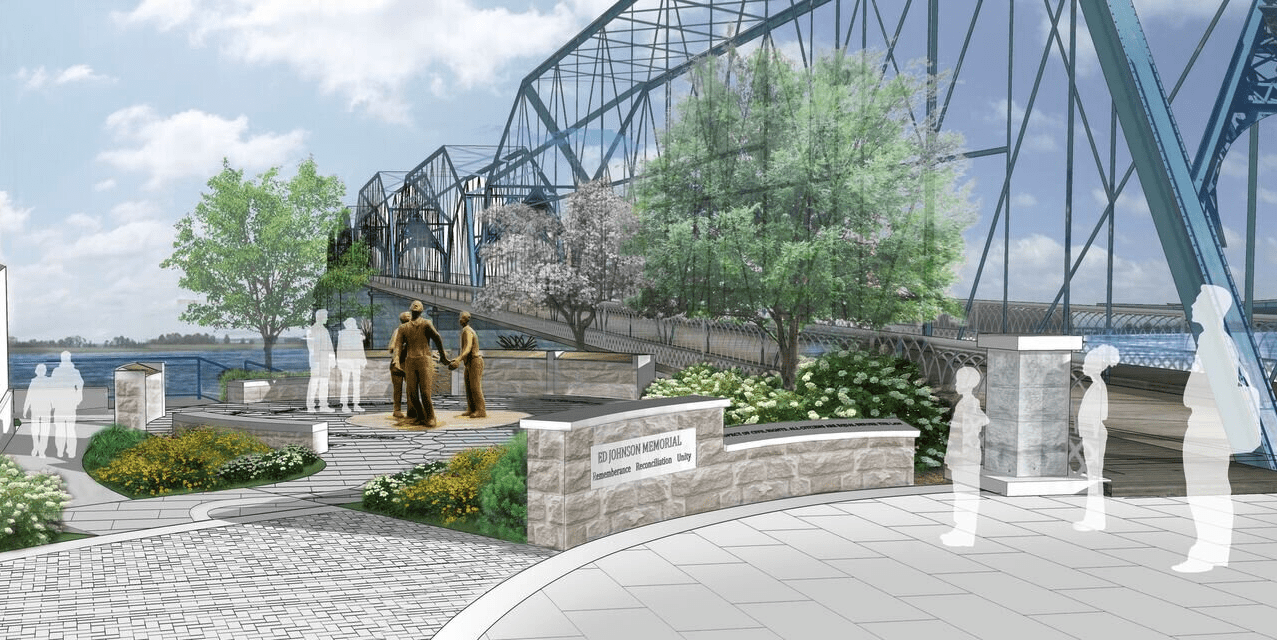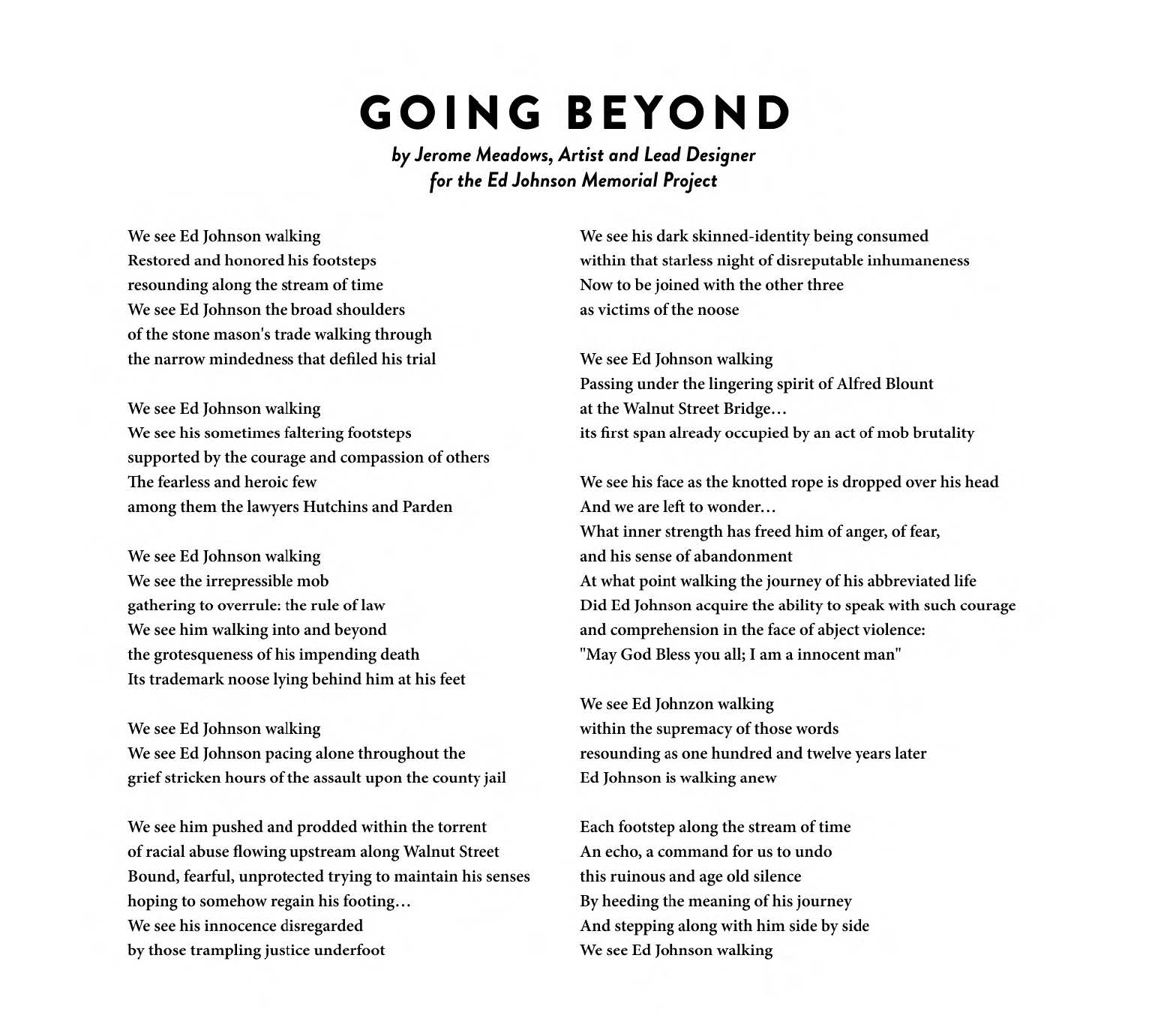
Family & Educators Guide to the Ed Johnson Memorial
This guide and the linked resources within it are designed to support open dialogue about discussing racial violence and lynching in the United States and specifically in Hamilton County, Tennessee. You are encouraged to use them in connection with the Ed Johnson Memorial and its accompanying written information.
The best way to begin these difficult conversations is to have tools and vocabulary available to clearly express the history of racial injustice and violence in age-appropriate and honest ways.
It is important to look at what we, as educators and learners, already know and what we need to learn about the history of racial violence in the United States.
Lynching and the discussion of these occurrences is often an uncomfortable and emotional endeavor. Learning about lynching, slavery, and racial terror is difficult for people of all ages and should be approached with care and consideration.
Before you begin, check in with yourself—how are you feeling? Where do you need to be supported? What do you need to learn?
Create a safe space, without distractions, to find out what the youth in your life know or need to know about current events and issues like racial violence and lynching. Most importantly, listen deeply and acknowledge their feelings.
Answer their questions as best you can—offer information in small doses, and research vocabulary, history and other resources like the ones in this guide to support them (and yourself) in understanding the impact of these events. If you aren’t able to answer their questions, be open about your own learning process and offer to find the answers for them.
Beyond terror and trauma are stories of resistance and resilience.
Work together to commit to action in ways that feel empowered and comfortable. Action can look like many things, from protests and petitions, to speaking out to active listening. Reading books on relevant topics, listening to appropriate podcasts or documentaries or following activist and community leaders on social media are all action steps. These actions are the foundation of positive change.
12 terms to begin conversations about race
- Activism: Efforts to raise awareness and create social, economic, political, or environmental change.
- Bias: When a person prefers one thing or person over another without giving an equal chance to both.
- Ethnicity: Cultural characteristics that connect certain groups.
- Equality: Everyone is treated, measured, esteemed, and valued the same.
- Equity: Everyone is given what they need to be successful, even if those things are not the same.
- Inclusion: The state of being included, valued, and respected for who you are, no matter what abilities you may or may not have.
- Justice: Upholding what is moral, equitable, and fair for all people.
- Prejudice: Judging or having an opinion about someone before you know them.
- Privilege: A right, advantage, or immunity only granted or available to a particular person or group.
- Race: is a social construct, a human-invented classification system invented as a way to define physical differences between people and has often been used as a tool for oppression and violence.
- Racism: A belief that certain races of people are, by birth and nature, superior to—or better than—others.
- Stereotype: An idea or belief that many people have about a particular group of people (or thing), often rooted in prejudice.
(from https://www.kindercare.com/content-hub/articles/2020/september/anti-bias-vocabulary and https://centerforhealthprogress.org/blog/race-social-construct/)
MORE RESOURCES FOR FAMILIES
PBS KIDS Talk About Race & Racism
A Collection of Resources for Teaching Social Justice
Common Sense Media
Talking to Kids about Racial Violence, by Haig Chahinian
Too great a burden to bear by Sabrina Joy Stevens
What White Children Need to Know about Race by Ali Michael and Eleonora Bartoli
For 4th – 12th Grade Educators
Addressing Lynching and Racial Violence: Discussion and Classroom Connections
History, despite its wrenching pain,
Cannot be unlived, but if faced
With courage, need not be lived again. -Maya Angelou, On the Pulse of Morning
In the United States, there is a legacy of racial inequality shaped by the enslavement of millions of Black people. The era of slavery was followed by decades of terrorism and racial subordination, most dramatically evidenced by lynching. Avoiding honest conversation about this history has undermined our ability to build a nation where racial justice can be achieved. (Equal Justice Initiative, www.eij.org)
Classroom Connections: Adaptable for grades 4th-12th
TN Social Studies Standards: SSP.05 Developing historical awareness
TN Foundational Literacy Standards: FL.VA.7 Cornerstone: Determine or clarify the meaning of unknown and multiple-meaning words and phrases by using context clues, analyzing meaningful word parts, and consulting general and specialized reference materials, as appropriate.
TN Visal Art Standards: VA.R2 Interpret intent and meaning in artistic work.
VA.Cr2 Organize and develop artistic ideas and work.
VA.Cn3 Relate artistic ideas and works with societal, cultural, and historical context
ACTIVITY SUGGESTIONS
We have seen in recent history how monuments that commemorate the past in ways that tell only one side of the story have been altered, deconstructed and/or removed by citizens who want to expand and update the way we look at historical figures and events. New memorials, like the Ed Johnson Memorial and The National Memorial for Peace and Justice in Montgomery, Alabama, are examples of this broader, more transparent and accountable discussion of United States history.
Part #1
Read the following poem by Jerome Meadows, the Ed Johnson Memorial sculptor and artist.
Work in small groups to address the questions below, then discuss as a class.
Stop to look up words and ask questions about their meaning in connection with the story in the poem.
INSTRUCTIONS
- How are specific words used to create emotions?
- List examples. (i.e. trademark- used in conjunction with the noose, referencing its common use in lynching and foreshadowing what will happen next)
- How do the different people in the poem feel—the white mob, the black community, and Ed Johnson at the center? Can you find specific examples of their expressed emotions in the text?
- What can be learned about the terror of lynching and the social and political impact of racism throughout United States history and today?

Part #2
Visit and research the Ed Johnson Memorial and other memorials that address the history and consequence of racial violence, like the National Memorial for Peace and Justice in Montgomery, Alabama. Use the resources below to facilitate research and discussion about these topics.
The Ed Johnson Memorial: https://www.edjohnsonproject.com/the-memorial/
National Memorial for Peace and Justice: https://museumandmemorial.eji.org/memorial
Equal Justice Initiative- Community Remembrance Project: https://eji.org/projects/community-remembrance-project/
Resource on the history and impact of lynching in America: https://lynchinginamerica.eji.org/report/
Teaching Race and Racism (High School Level curriculum): https://lynchinginamerica.eji.org/drupal/sites/default/files/2019-11/EJI%20High%20School%20Lesson%20Plan.pdf
DISCUSSION
What symbols were used to represent the people and the actions depicted by the memorials?
How do audiences physically view these works? How does this affect the interpretation and emotional impact of the work? Consider the size, location, materials, symbolism and written information (also known as didactics) provided at the memorial sites.
How is the Ed Johnson Memorial different than other monuments and memorials in and around Chattanooga, both in its physical construction and content?
Are there other memorials and installations in the city? Which ones are similar or aim to further the discussion on this issue?
- Think about a monument or memorial you believe could be more inclusive or one that could be made to address conversations and issues that are important to you.
- What would it look like? Consider materials, size, and location as well as symbolism.
- How would you change or alter an existing monument? Which one, how and why?
- Design and build your own monument.
- Share and discuss the artwork or design.
- Paper
- Air dry clay
- Markers
- Pencil
- Mixed media materials


